Call center workforce management (WFM) software is a tool designed to optimize the scheduling and management of employees in call centers. It helps ensure that the right number of agents are available at the right times to handle customer calls efficiently.

Streamlining Forecasting and Planning: A WFM tool plays a crucial role in accurate forecasting and planning, which are foundational to efficient call center operations. By analyzing historical data and identifying patterns, the tool predicts future call volumes and service demands with greater precision. This data-driven approach helps in anticipating peak periods and planning accordingly, ensuring that the right number of agents are available to meet customer needs. Accurate forecasting minimizes the risk of overstaffing or understaffing, which can lead to either wasted resources or poor service quality.
Optimizing Scheduling: Scheduling is a complex task that involves balancing various factors, including call volume forecasts, agent availability, and regulatory requirements. A WFM tool simplifies this by automating schedule creation and management. It takes into account various constraints such as shift preferences, time-off requests, and skill requirements to generate optimal schedules. This automation not only ensures that staffing levels are appropriate but also reduces the administrative burden on managers.
Enhancing Real: Time Management: Real-time management is critical for maintaining service levels and addressing issues as they arise. A WFM tool provides real-time visibility into key metrics such as call volume, average handle time, and service levels. This immediate access to data allows managers to monitor performance closely and make timely adjustments. For instance, if there is an unexpected surge in call volume, the tool enables managers to quickly reallocate resources or adjust workflows to handle the increased demand effectively.
Improving Performance Monitoring and Analytics: The performance monitoring capabilities of a WFM tool are vital for continuous improvement. It tracks a wide range of performance metrics, offering insights into agent productivity, call resolution rates, and overall efficiency. By analyzing these metrics, managers can identify trends, evaluate the effectiveness of current strategies, and pinpoint areas for improvement.
Facilitating Agent Engagement and Self-Service: A key aspect of operational efficiency is agent satisfaction and engagement. A WFM tool often includes self-service features that empower agents to manage their schedules, request time off, and view their performance data independently. This autonomy not only reduces the administrative load on managers but also increases transparency and job satisfaction among agents. When agents have access to real-time information and can make schedule adjustments or track their performance, they are more likely to feel valued and motivated.
Ensuring Compliance and Reducing Errors: Compliance with labor laws and regulations is essential for avoiding legal issues and maintaining fair labor practices. A WFM tool helps ensure compliance by incorporating features that manage labor rules and regulations automatically. It tracks working hours, breaks, and overtime, ensuring that schedules adhere to legal requirements.
Supporting Strategic Decision-Making: Beyond daily operations, a WFM tool provides strategic insights that support long-term planning and decision-making. By analyzing historical data and performance trends, the tool can help forecast future needs, plan for growth, and identify opportunities for process improvements.
Adapting to Change: The dynamic nature of call center environments requires a tool that can adapt to changing conditions. A robust WFM tool is flexible and scalable, accommodating shifts in call volume, business growth, or changes in workforce composition.
Workforce Management tool enhances call center efficiency by integrating advanced forecasting, scheduling, real-time management, and performance analytics capabilities. It streamlines operations, empowers agents, ensures compliance, and supports strategic decision-making, all of which contribute to a more efficient, responsive, and successful call center.
Nice
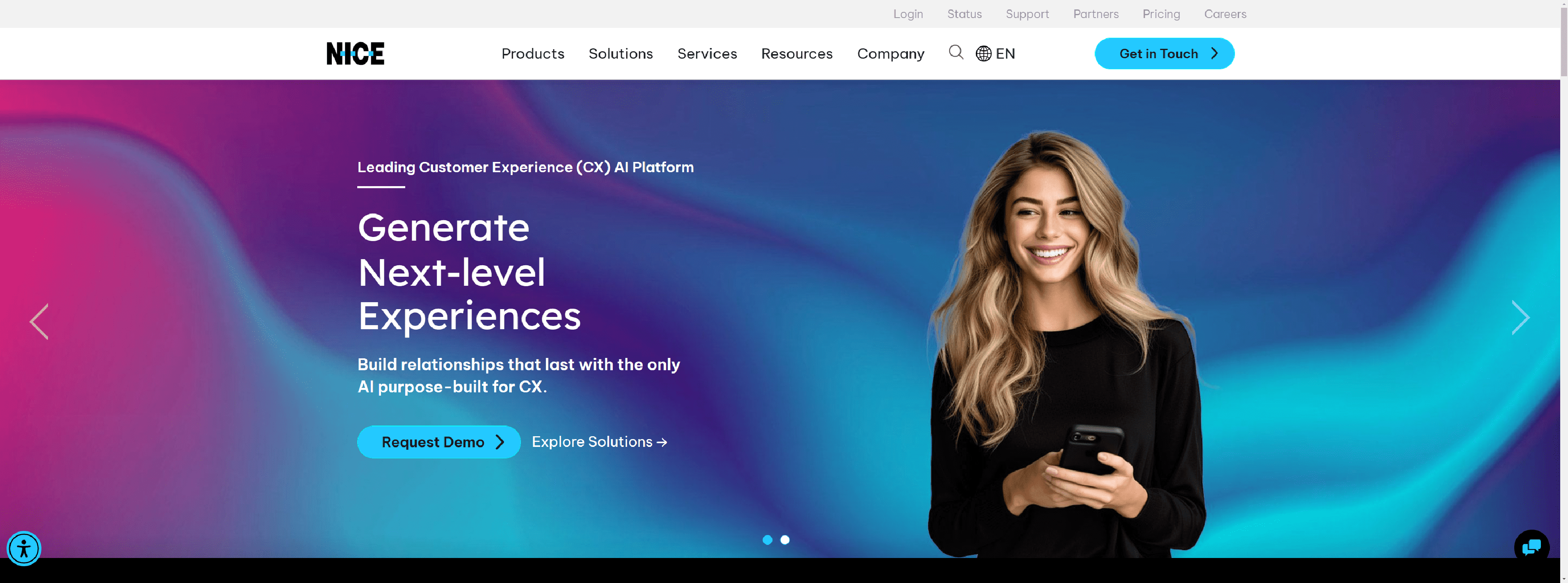
Nice – create consistency and satisfaction by transforming every customer interaction from one unified, cloud-native platform infused with specialized AI for CX.
- Enlighten AI for CX
- Journey Orchestration and Routing
- Workforce Engagement Management (WEM)
- Open Cloud Platform
- Digital and Self-Service
- CX Analytics
- Agent Assist
- Proactive Outreach
Five9
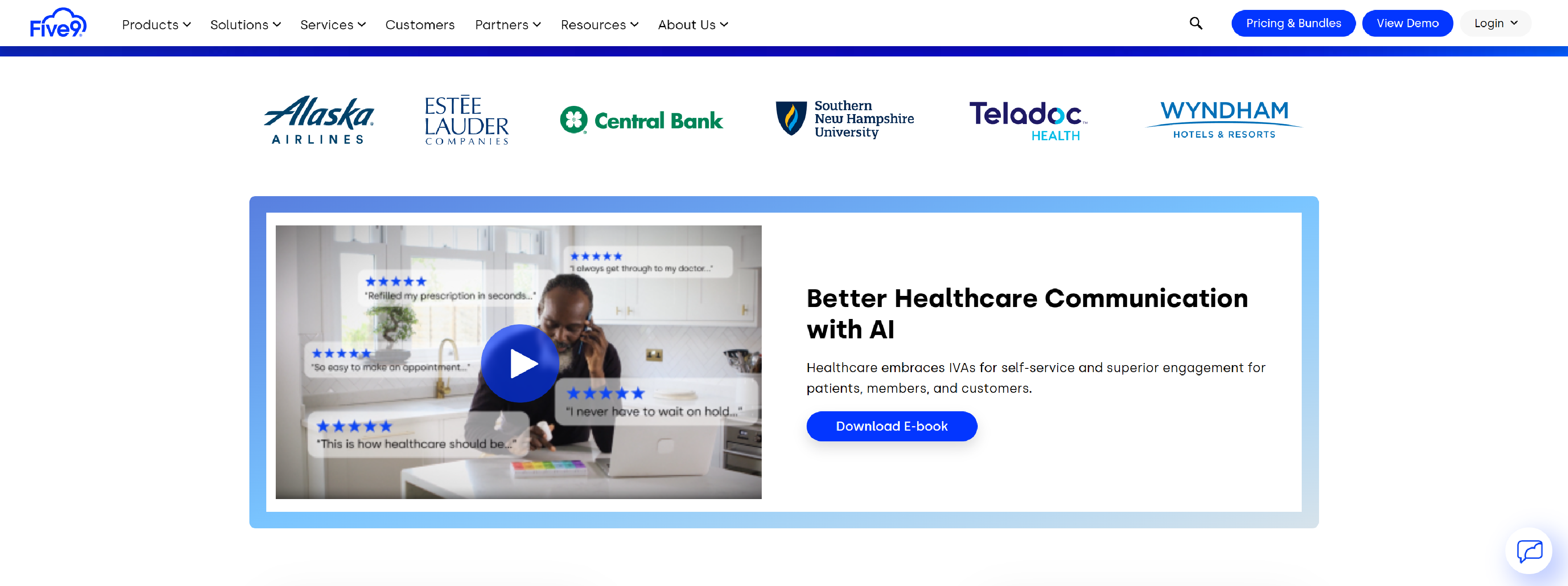
Five9 delivers the most reliable cloud contact center that empowers organizations to deliver extraordinary customer experiences.
- Call, screen, and digital channel transcription capture
- Real-time call and desktop monitoring
- Flexible evaluation form creation
- Powerful query capabilities
- Coaching packages
- Automated evaluation assignment
- Pre-built CRM integration with Salesforce, Zendesk, Oracle, and ServiceNow
- Multiple forecasting methods
- Multi-skill/multi-channel forecasting
- Rules-based agent-preference scheduling
- Intraday management and automated adjustment
- Real-time agent adherence
- Role-based, customizable dashboards
- Customizable KPIs and metrics
- Real-time performance visibility
- Data aggregation from external sources
- Wallboards
- Gamification
- And more.
Alvaria
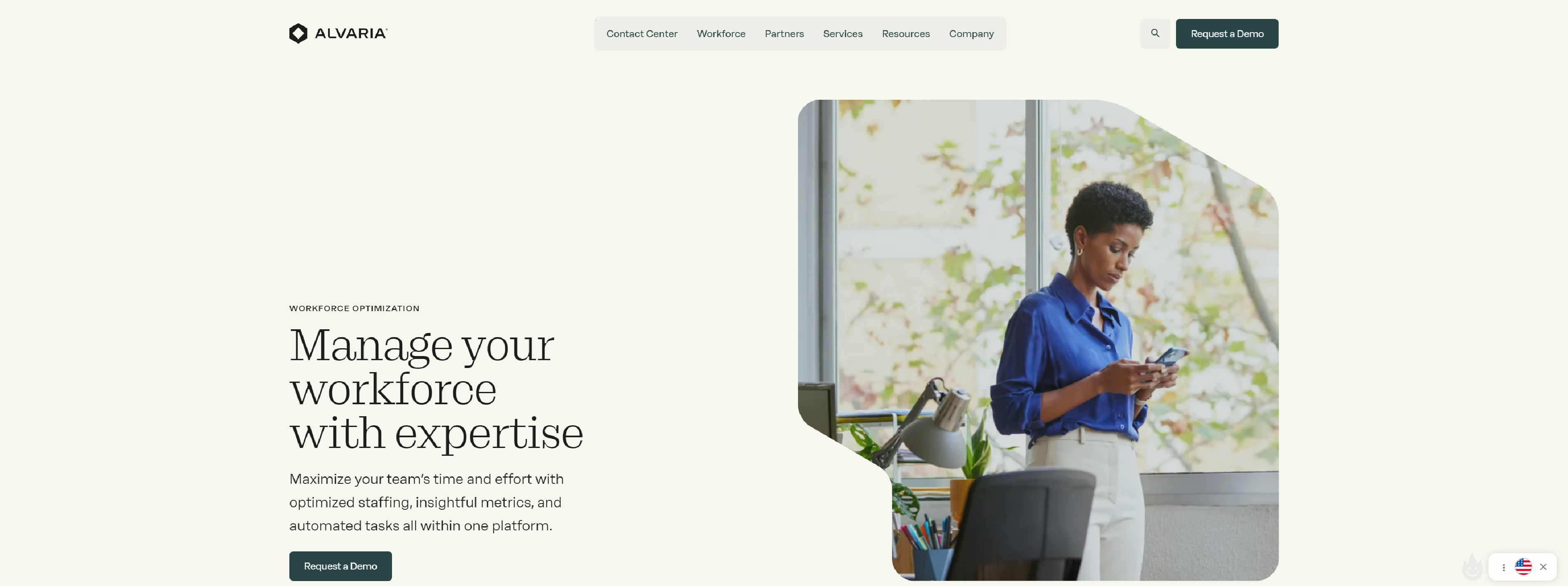
Alvaria – Maximize your team’s time and effort with optimized staffing, insightful metrics, and automated tasks all within one platform.
- Giving teams a reason to be at their best
- Putting productivity in the hands of your team
- Understand your workforce on a whole new level
Eleveo
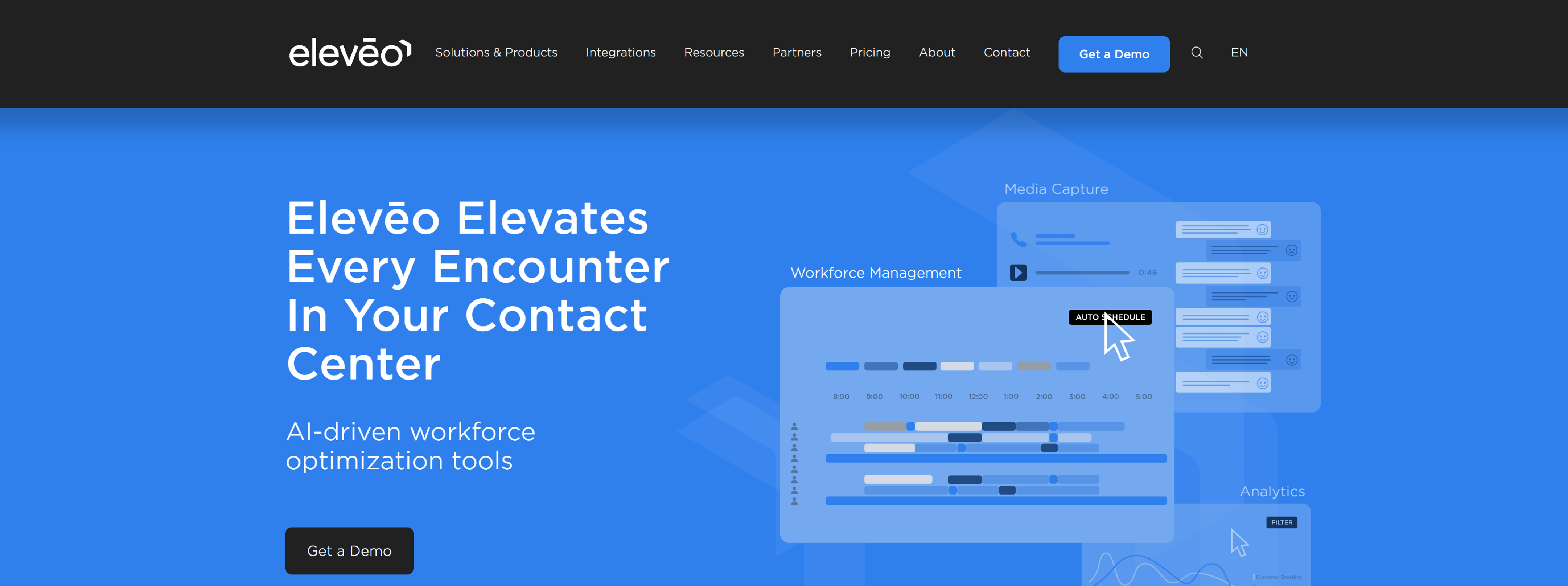
Optimize your call center with Eleveo’s Workforce Management solutions. Ensure the right agents are in the right seats at the right times.
- Customers expect staff availability and quality service
- Staff expects work-life balance and work satisfaction
- Management expects efficient, profitable, sustainable operations
Intradiem
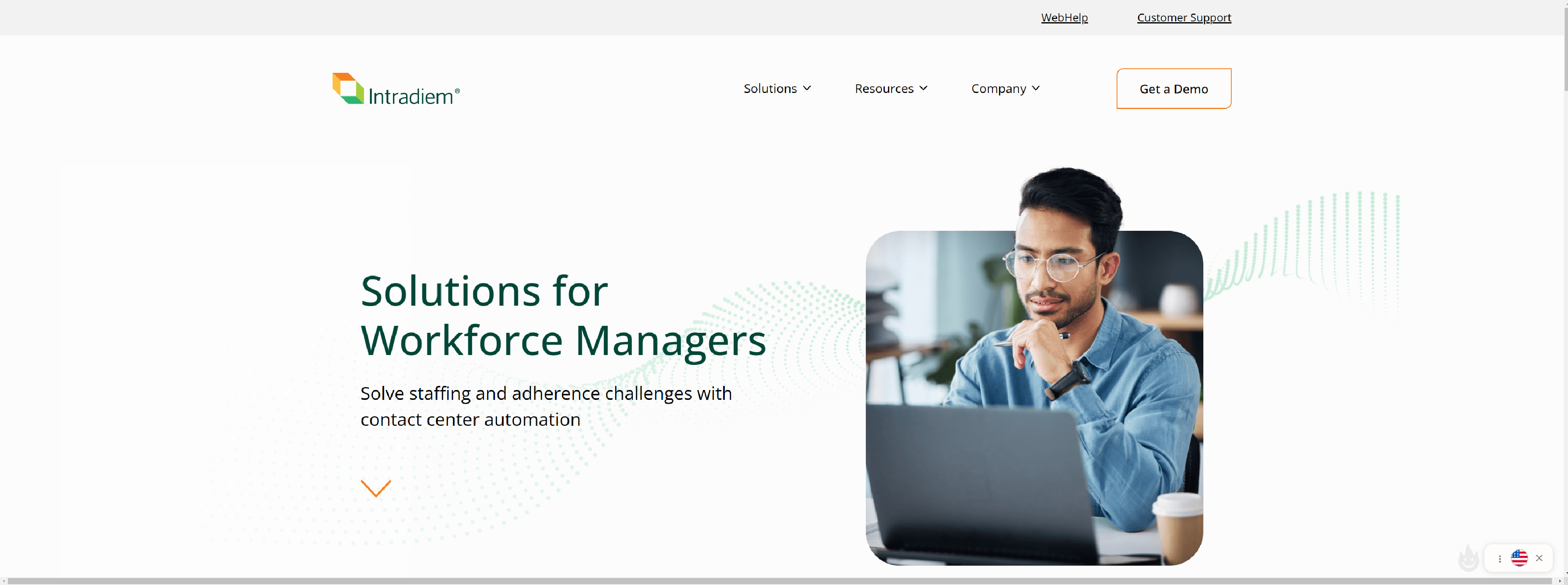
Intradiem – contact center automation platform integrates easily with your ACD and WFM systems, offering real-time support to frontline agents.
- Dynamically manage intraday scheduling
- Monitor and assist agent activity
- Proactively ensure breaks for agents
Route101
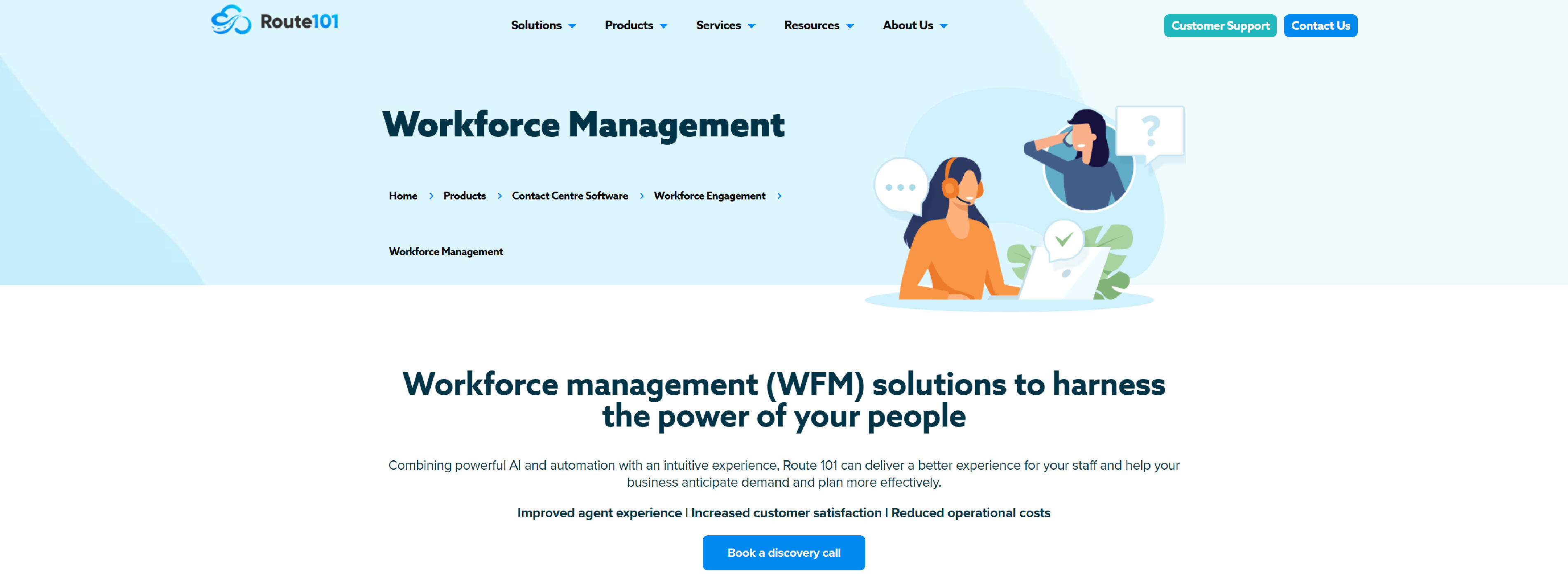
Route 101 can deliver a better experience for your staff and help your business anticipate demand and plan more effectively.
- Empower agents and supervisors
- Give agents more flexibility
- Provide daily insights
- Reduce manual WFM processes
- Be more agile
- Speed up workforce manager proficiency
- Forecast and schedule intelligently
- Improve long-term planning
- Harness gamification to drive performance and productivity
Selection Criteria for Call Center Workforce Management Software
Call Center Workforce Management (WFM) software involves considering various factors to ensure it meets your organization’s needs. Here are some key selection criteria to guide you:
1. Functionality and Features
- Forecasting and Scheduling: Evaluate the software’s ability to accurately forecast call volumes and create efficient schedules.
- Real-time Monitoring: Ensure it provides live updates on key metrics and agent performance.
- Intraday Management: Check if it allows for real-time adjustments to handle unexpected changes in call volume.
- Performance Analytics: Look for robust reporting and analytics capabilities to track KPIs and performance trends.
- Agent Self-Service: Assess the ease with which agents can access and manage their schedules and requests.
2. Integration Capabilities
- Compatibility with Existing Systems: Ensure the WFM software integrates seamlessly with your current CRM, ACD, and other relevant systems.
- API Availability: Check if it offers APIs for custom integrations and future scalability.
3. User Experience
- Ease of Use: The software should be intuitive and user-friendly for both administrators and agents.
- Customizability: It should allow for customization to fit your specific workflows and business needs.
4. Scalability
- Capacity: Ensure the software can scale with your organization’s growth, whether that means handling more agents, additional features, or expanding to multiple locations.
5. Support and Training
- Customer Support: Evaluate the level of support provided, including availability, responsiveness, and expertise.
- Training Resources: Check if the vendor offers training materials, webinars, or on-site training to help your team get up to speed.
6. Cost and Pricing Structure
- Total Cost of Ownership: Consider not just the upfront costs but also ongoing expenses such as maintenance, updates, and support.
- Pricing Model: Look for transparency in pricing and flexibility in terms of licensing options (e.g., per user, per agent, or subscription-based).
7. Vendor Reputation and Stability
- Vendor Experience: Consider the vendor’s track record and experience in the call center industry.
- Customer Reviews: Look for customer testimonials and case studies to gauge user satisfaction and reliability.
8. Implementation and Deployment
- Deployment Options: Determine if the software is cloud-based, on-premises, or offers a hybrid solution, and assess which best fits your needs.
- Implementation Time: Evaluate the time required to deploy and integrate the software into your existing systems.
9. Flexibility and Adaptability
- Future Updates: Consider how the software handles updates and new feature releases.
- Adaptability: Ensure it can adapt to changes in your business environment or industry requirements.
Carefully evaluating these criteria will help you select a Call Center Workforce Management software that aligns with your operational needs and supports your overall business objectives.
Workforce Management (WFM) is crucial in call centers for several reasons, impacting efficiency, service quality, and employee satisfaction.
Optimizing the Workforce Management Call Center Process
Optimizing the Workforce Management (WFM) process in a call center involves creating a harmonious balance between forecasting, scheduling, real-time management, and performance analysis to enhance operational efficiency and improve both customer and employee satisfaction.
Understanding the Bigger Picture
To optimize WFM, start by recognizing its integral role in the call center’s ecosystem. The goal is not merely to fill shifts but to ensure that the right number of skilled agents are available at the right times to meet customer demand efficiently. This involves aligning WFM practices with broader business objectives, such as improving customer service, reducing operational costs, and enhancing agent satisfaction.
Data-Driven Forecasting
Accurate forecasting is the cornerstone of effective workforce management. Begin by leveraging historical data and predictive analytics to anticipate future call volumes and service demands. This means analyzing past call patterns, seasonality, and other relevant factors to create reliable forecasts. Emphasize the importance of using this data to plan staffing needs, and continuously refine your forecasting methods based on new data and emerging trends.
Dynamic Scheduling
Scheduling is more than just assigning shifts; it’s about creating a plan that maximizes efficiency while accommodating the needs of both the business and the employees. Develop schedules that align with your forecasted needs, taking into account peak periods and ensuring that agents with the appropriate skills are available. Incorporate flexibility into scheduling to handle unexpected changes, such as sudden spikes in call volume or agent absences. Effective scheduling not only ensures adequate coverage but also helps in managing employee preferences and minimizing burnout.
Real-Time Management
Managing a call center in real-time requires a proactive approach. Implement tools and practices that allow for immediate visibility into current operations. This includes monitoring key metrics such as call volume, average handle time, and service levels. Real-time management involves being able to make quick adjustments to staffing levels or workflows in response to live data. For instance, if a sudden increase in call volume is detected, you should be able to deploy additional resources swiftly or adjust agent tasks to address the surge.
Performance Analysis and Improvement
Once you have a handle on forecasting, scheduling, and real-time management, the next step is to focus on performance analysis. Utilize data to assess the effectiveness of your WFM strategies. Analyze key performance indicators (KPIs) such as service levels, first call resolution, and agent productivity to gauge how well your workforce management is working. Identify trends, areas of improvement, and potential bottlenecks. Use these insights to continuously refine your strategies, implement best practices, and address any issues that may arise.
Empowering Your Team
Optimizing the WFM process also involves empowering your team with the right tools and knowledge. Train managers and agents on WFM principles and software usage, and foster a culture of continuous improvement. Encourage feedback from both managers and agents to identify challenges and opportunities for enhancement. By creating an environment where everyone understands their role and how it fits into the larger WFM strategy, you enhance overall efficiency and satisfaction.
Leveraging Technology
Invest in advanced WFM technology that supports forecasting, scheduling, real-time management, and performance analysis. Modern WFM software can automate many aspects of these processes, providing accurate forecasts, efficient scheduling, and real-time insights. Ensure that the technology you choose integrates well with other systems, such as CRM and ACD, to provide a comprehensive view of operations.
Continuous Adaptation
Finally, recognize that workforce management is not a static process but one that requires continuous adaptation. Regularly review and update your forecasting models, scheduling practices, and real-time management strategies to reflect changes in business conditions, customer expectations, and workforce dynamics. Stay informed about industry trends and emerging best practices to ensure that your WFM processes remain effective and relevant.
Optimizing the WFM process in a call center involves a holistic approach that integrates data-driven forecasting, dynamic scheduling, real-time management, and continuous performance analysis. By aligning these elements with broader business objectives and empowering your team with the right tools and knowledge, you can enhance operational efficiency, improve customer service, and increase employee satisfaction.
Workforce Management Call Center Training: Empowering Your Team
Training your call center team in Workforce Management (WFM) is pivotal for operational success and employee satisfaction. The goal is to equip both management and agents with the skills and knowledge they need to effectively manage staffing, enhance performance, and improve customer service. Here’s a deeper dive into how to empower your team through WFM training:
Building a Strong Foundation
Start by establishing a solid understanding of the core principles of WFM. Managers and agents should be well-versed in the basics of forecasting, scheduling, real-time management, and performance analysis. This foundational knowledge is crucial for everyone involved to grasp the importance of WFM and how it impacts their daily tasks and the overall call center operation.
Practical Application for Managers
For managers, the training should focus on the practical application of WFM tools and techniques. Managers need to be adept at forecasting future call volumes and planning staffing requirements accordingly. Training should include hands-on sessions where managers practice creating schedules, handling time-off requests, and making real-time adjustments based on live data. By simulating real-life scenarios, managers can better understand how to respond to unexpected changes and maintain service levels.
Empowering Agents
Agents should also receive training on how to effectively use self-service tools for managing their schedules and accessing performance data. It’s essential to explain the importance of adherence to schedules and how their performance directly affects team goals and customer satisfaction. Providing agents with the knowledge to manage their schedules and understand performance metrics helps them feel more in control and accountable for their contributions.
Leveraging Technology
Both managers and agents should be comfortable with the WFM software in use. Training should include comprehensive tutorials on the software’s features and functionalities. For managers, this might mean advanced training on how to generate and interpret reports, while for agents, it could involve learning how to navigate their schedules and view their performance metrics. Hands-on practice with the software helps solidify learning and builds confidence in using these tools effectively.
Continuous Improvement and Support
WFM training shouldn’t be a one-time event but an ongoing process. Regular refresher courses and updates on new features or best practices are crucial for keeping the team up-to-date. Encourage a culture of continuous learning where team members can share their insights and challenges. This could involve setting up forums or regular meetings where staff can discuss their experiences and learn from one another.
Measuring Success
To ensure the effectiveness of the training program, it’s important to assess its impact regularly. Use performance metrics to gauge improvements in call handling, scheduling accuracy, and overall efficiency. Feedback from both managers and agents can provide valuable insights into what’s working well and what might need adjustment. This iterative approach helps refine the training program and align it with the evolving needs of the call center.
Aligning with Organizational Goals
Align WFM training with the broader goals of the organization. Whether the focus is on improving customer satisfaction, reducing costs, or increasing operational efficiency, ensure that the training supports these objectives. Clear communication about how WFM practices tie into the company’s strategic goals can motivate and guide the team in applying what they’ve learned.
By focusing on these elements, you create a robust WFM training program that empowers your call center team. Effective training not only improves the management of workforce resources but also enhances job satisfaction, operational efficiency, and customer experience, driving overall success for the call center.
Q&A on Call Center Workforce Management (WFM) Software
What is Call Center Workforce Management Software?
Answer: Call Center Workforce Management Software is a tool designed to help call centers manage their staffing needs effectively. It aids in forecasting call volume, scheduling staff, and ensuring that the right number of agents are available at the right times to meet service level objectives.
How does this software help with forecasting?
Answer: The software uses historical data and predictive analytics to forecast future call volumes. It can analyze patterns such as peak times and seasonal variations to predict the number of agents needed at different times.
How does it improve efficiency in a call center?
Answer: By accurately forecasting demand and optimizing schedules, the software ensures that there are enough agents available to handle calls without overstaffing or understaffing. This improves operational efficiency, reduces costs, and enhances customer service.
Can this software integrate with other systems?
Answer: Yes, most workforce management systems can integrate with other call center technologies, such as Customer Relationship Management (CRM) systems, Automatic Call Distributors (ACD), and Human Resources Management Systems (HRMS). This integration helps streamline operations and data flow across different platforms.
How does the software handle unexpected changes in call volume?
Answer: Advanced workforce management software includes intraday management capabilities that allow call centers to adjust schedules in real time based on sudden changes in call volume. It can suggest adjustments or even reallocate resources as needed.